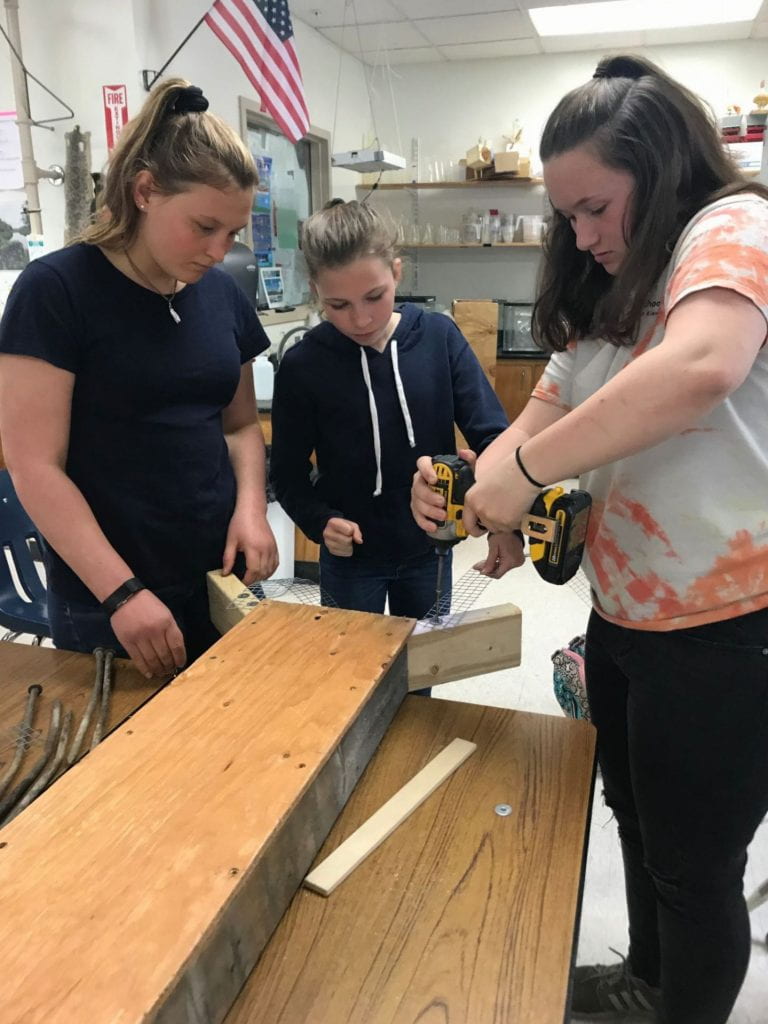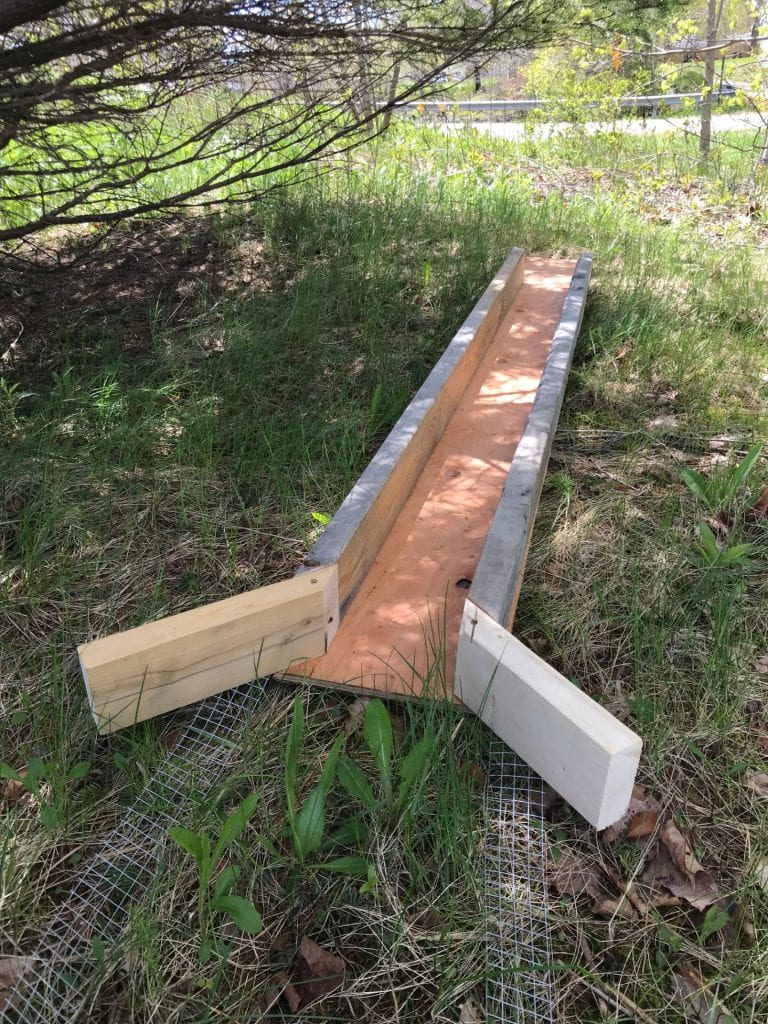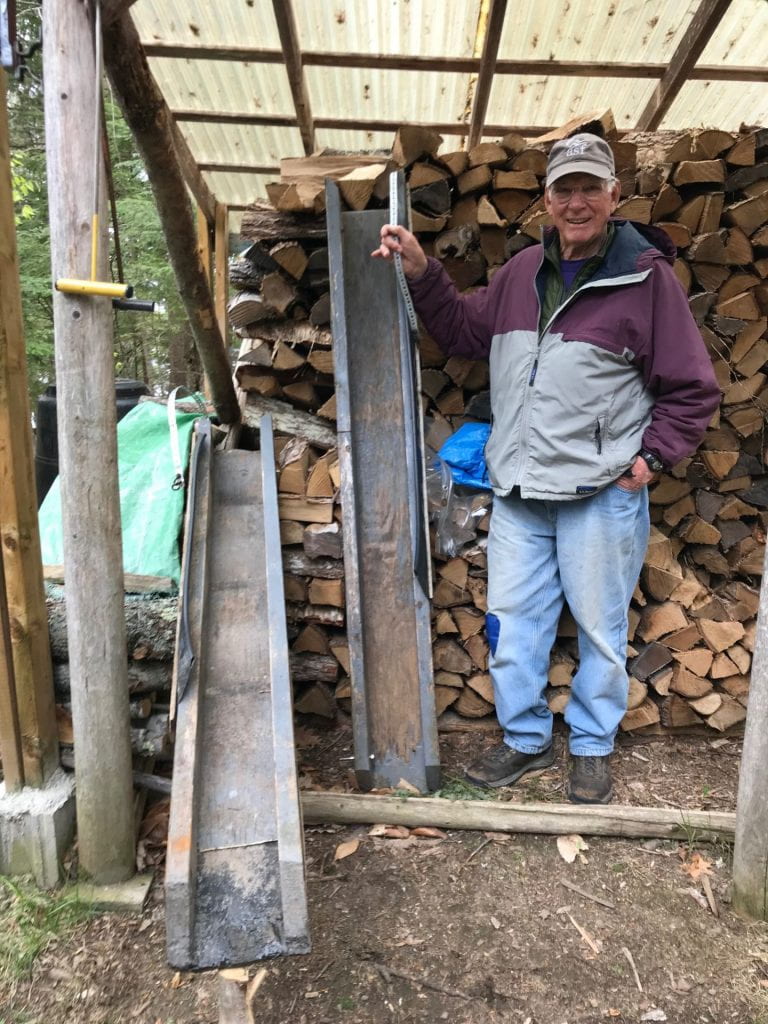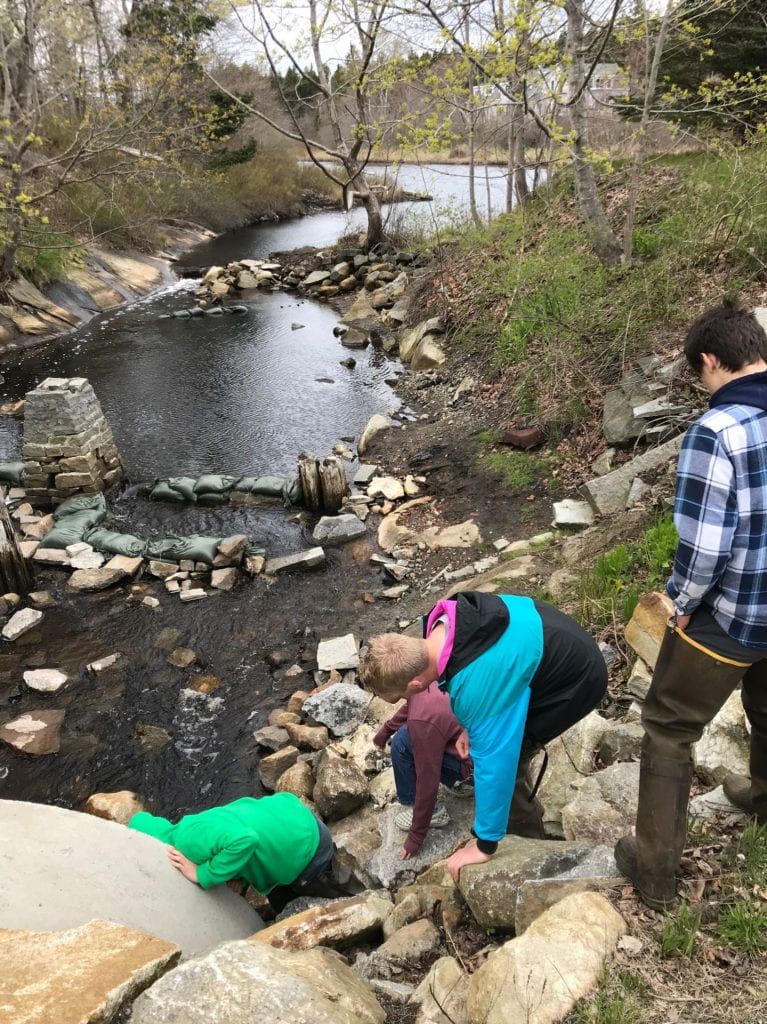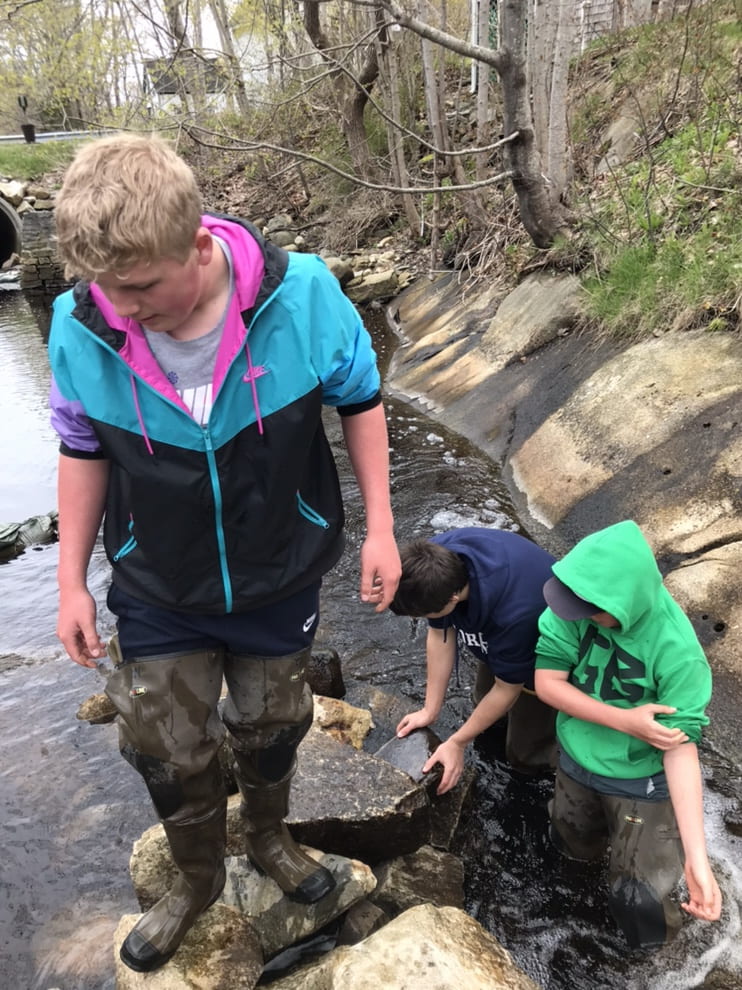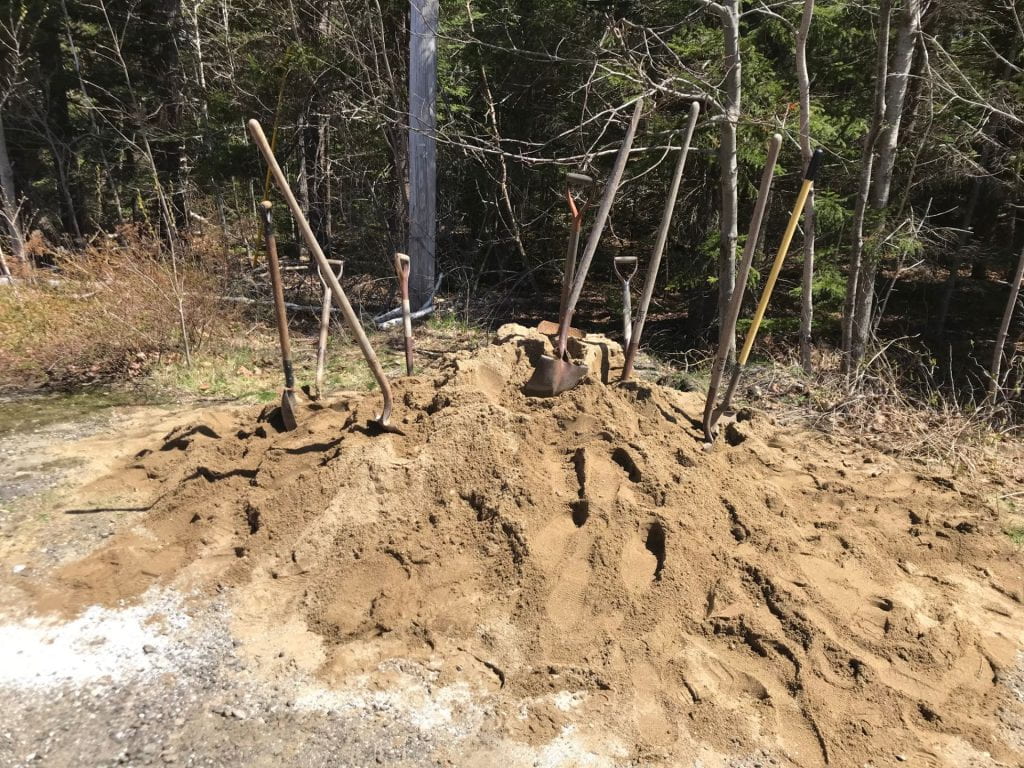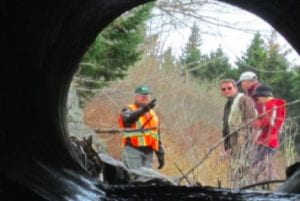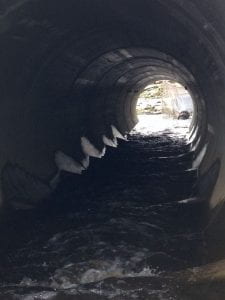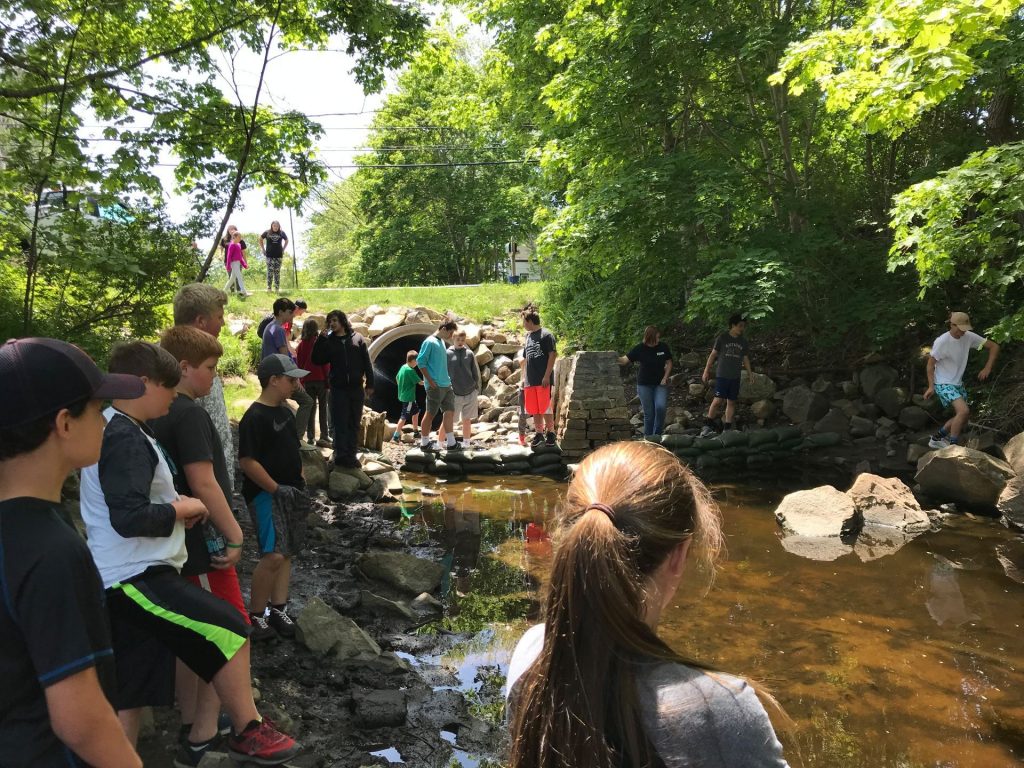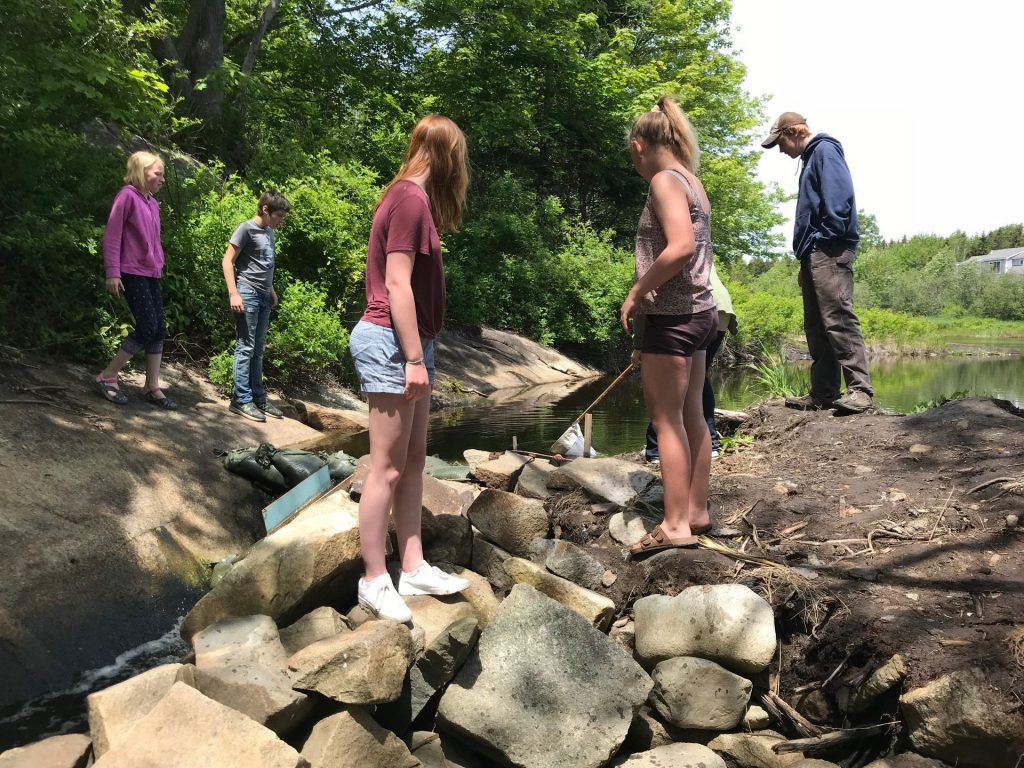Visiting Damariscotta and Warren – The Run is ON!
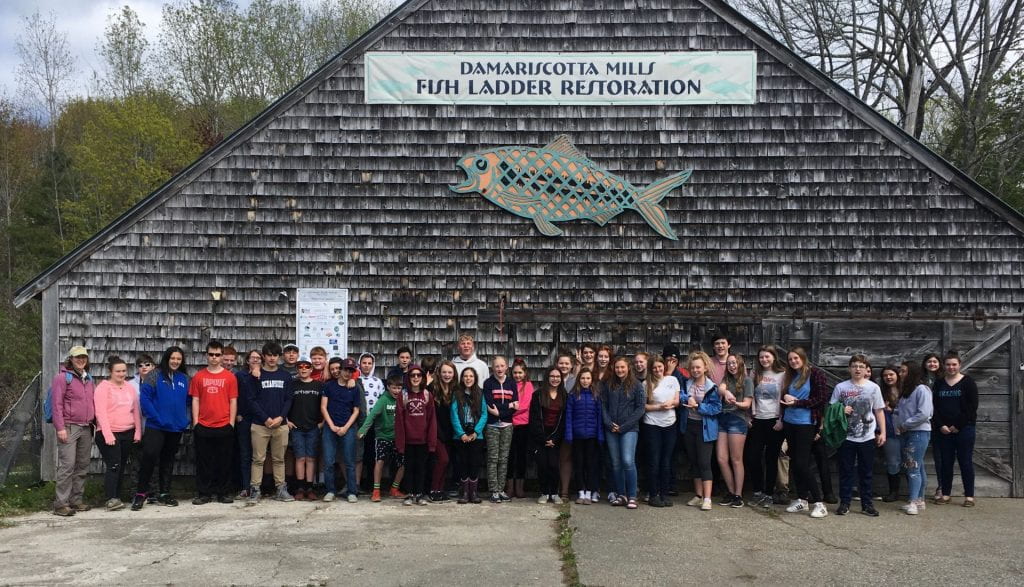 The fish ladder in Damariscotta wasn’t how I remembered it looking, I had remembered a more mechanical look to the fish ladder, probably because I was like seven, the last time I saw it. As for the Warren fish ladder, I hadn’t been expecting it to look so flat. At both the Damariscotta and Warren fish ladders there were tons of fish in each area, even in the trap at Warren, where they would take scales for the researchers, even in that area there were tons of fish. I honestly wasn’t expecting to see so many fish there, it was mind boggling. Especially when we were at the part with the set stone, just seeing the fish swim up to the next pool. Although it was really cool to watch, during the whole thing I had wondered how exhausting it must have been to be a fish and swim up one of those fish ladders, because it’s such a long swim and all the water pressure must make it so hard! So near the duck boards, the thing I wondered about the most were the metal things that looked like a excavator’s bucket, but larger and meant for water. While we were at that part I had been wondering what the purpose of it was. I would say the thing I understand better is how badly a run can get affected by a dam or mill. An example of that would be Damariscotta. The natural fish run got blocked by a dam, and in 1741 legislature wanted a way for the fish to get through. However, this didn’t get done until 1807, when they built the fish ladder. I didn’t know that the fish ladder in Damariscotta went up about 40 feet. That height is massive in my opinion for a fish, especially with all the water pressure going against them. It makes me wonder if after long enough, when we get a good fish ladder built, if we can have at least a fraction of the amount of fish they have in Damariscotta. Henry
The fish ladder in Damariscotta wasn’t how I remembered it looking, I had remembered a more mechanical look to the fish ladder, probably because I was like seven, the last time I saw it. As for the Warren fish ladder, I hadn’t been expecting it to look so flat. At both the Damariscotta and Warren fish ladders there were tons of fish in each area, even in the trap at Warren, where they would take scales for the researchers, even in that area there were tons of fish. I honestly wasn’t expecting to see so many fish there, it was mind boggling. Especially when we were at the part with the set stone, just seeing the fish swim up to the next pool. Although it was really cool to watch, during the whole thing I had wondered how exhausting it must have been to be a fish and swim up one of those fish ladders, because it’s such a long swim and all the water pressure must make it so hard! So near the duck boards, the thing I wondered about the most were the metal things that looked like a excavator’s bucket, but larger and meant for water. While we were at that part I had been wondering what the purpose of it was. I would say the thing I understand better is how badly a run can get affected by a dam or mill. An example of that would be Damariscotta. The natural fish run got blocked by a dam, and in 1741 legislature wanted a way for the fish to get through. However, this didn’t get done until 1807, when they built the fish ladder. I didn’t know that the fish ladder in Damariscotta went up about 40 feet. That height is massive in my opinion for a fish, especially with all the water pressure going against them. It makes me wonder if after long enough, when we get a good fish ladder built, if we can have at least a fraction of the amount of fish they have in Damariscotta. Henry
I think the fish in Damariscotta and Warren were really cool. I have never seen so many fish in one spot, it looked like millions. It was also cool to see the fish in the different sections going up to the spot where they spawn and seeing the process. One thing I noticed is that they were all in the middle of the stream and there were none on the sides and that there were so many that you couldn’t see the water. Really, there were a lot more than expected. I wondered how many there actually were. I found it interesting how many there were and that there were not more birds, and that (biologists) can see how old the fish are by their scales. I understand now how many fish there are and how they catch them to sell. I learned that they see the age of the fish the same way they do with trees. That experience makes me wonder if our run was ever that plentiful or if it ever will be. James
The run in Damariscotta was being aided a lot by the fish ladder, and you could really tell that it was very easy for them to climb to the lake. It seemed that at both (places), the seabirds were heavily crowding, which tells me that the alewives are a very important food source in those two locations. I’ve seen the Damariscotta run before, but not when it was at its peak like it was. The amount of fish really surprised me at both locations. Damariscotta definitely had more fish swimming upstream, which makes me curious about why that is. I also wonder how there are so many when Damariscotta lake is relatively small, and I am imagining that it would be extremely full of alewives at some points. In Warren, I didn’t quite understand the cage contraption because it seemed that all of the alewives were swimming into it. I also wasn’t sure about how the chute in Damariscotta was operated. It was very interesting to me how the fish ladder was working so well, and how they successfully got back their run. After it all, I understood more about how important alewives are to the ecosystem they are part of, and the communities they swim through. Something that helped me understand this more was seeing the smokehouse, which I didn’t know about before this. After the experience, I felt more inspired to do more at our run to help the alwives swim upstream to the marsh. Since we’ve begun to restore our run, I have felt more optimistic about our run returning to its original and healthy state. Lute
 When we first walked along the road onto the bridge to overlook the river in Damariscotta I spotted a few fish close to the left side. I soon realized that the whole black mass in which I had just assumed was the shadow on the water, was all fish. In Warren, I was more interested in the cage in which they caught the fish than the fish themselves as I has expressed my amazement of the amount of fish in Damariscotta. It was cool for me to see Warren specifically because that is where my dad goes to get his bait in the spring. When he does this he tells me about how most times he has to wait on a list but sometimes he can get them right when he arrives. That being said, I was wondering what the setup was there and now I understand and can picture what is he is talking about. There was an amazing amount of fish. I wonder if someday we will have an awesome amount of fish like that here in our Marsh. At first I wasn’t sure why it didn’t seem that the fish were going anywhere but after asking Mrs. England I found out that they were most likely waiting for the tide or amount sunlight to change. The thing I found the most interesting is the pools. Not necessarily the pools themselves but the way the alewives just launch themselves up into the next one. That day I learned that alewives like the tides and the sunlight to be right before they will enter their body of water to spawn. The experience that day made me hopeful that with all of our efforts that in day our run will be just half as good as that one. Lydia
When we first walked along the road onto the bridge to overlook the river in Damariscotta I spotted a few fish close to the left side. I soon realized that the whole black mass in which I had just assumed was the shadow on the water, was all fish. In Warren, I was more interested in the cage in which they caught the fish than the fish themselves as I has expressed my amazement of the amount of fish in Damariscotta. It was cool for me to see Warren specifically because that is where my dad goes to get his bait in the spring. When he does this he tells me about how most times he has to wait on a list but sometimes he can get them right when he arrives. That being said, I was wondering what the setup was there and now I understand and can picture what is he is talking about. There was an amazing amount of fish. I wonder if someday we will have an awesome amount of fish like that here in our Marsh. At first I wasn’t sure why it didn’t seem that the fish were going anywhere but after asking Mrs. England I found out that they were most likely waiting for the tide or amount sunlight to change. The thing I found the most interesting is the pools. Not necessarily the pools themselves but the way the alewives just launch themselves up into the next one. That day I learned that alewives like the tides and the sunlight to be right before they will enter their body of water to spawn. The experience that day made me hopeful that with all of our efforts that in day our run will be just half as good as that one. Lydia
I thought the fish were pretty cool…seeing them swim in these tight formations, a little hard to see but if you could see them, they were cool. I noticed the fish weren’t really moving. They seemed to look like they were but they weren’t. It was puzzling. Also, in Warren the fish couldn’t really move and in Damariscotta they could move but it seemed like they moved just about the same. There was a lot more fish than I expected; I expected a few here and a few there but there was a lot more…I found the look and the detail of these fish most interesting. I understand what these look like the fish, and the fish ladder more. I learned that there have been poachers in Warren that take as many fish as they can get without giving back. It makes me think of how it may have used to be, back then. Shaun
 I was really impressed that there were thousands upon millions of alewives there, and seeing all the scales in the water in Damariscotta, and at Warren the amount of fish flowing through was incredible. Yes, there were a lot of fish, more than I expected. I thought they would be like a small group, but there was a giant line of fish, like a traffic jam. I noticed that they travel in packs, and I saw a rim of a boat, or a buried boat on the top of the waterfall were the alewives are counted. I was most interested in the traffic jam of fish, there were so many fish. I was astonished! Thomas
I was really impressed that there were thousands upon millions of alewives there, and seeing all the scales in the water in Damariscotta, and at Warren the amount of fish flowing through was incredible. Yes, there were a lot of fish, more than I expected. I thought they would be like a small group, but there was a giant line of fish, like a traffic jam. I noticed that they travel in packs, and I saw a rim of a boat, or a buried boat on the top of the waterfall were the alewives are counted. I was most interested in the traffic jam of fish, there were so many fish. I was astonished! Thomas
I think that the whole experience was really cool, and I enjoyed seeing all the alewives, as they tried to make their way upstream. It was amusing to see the alewives move as a whole…one alewife would move and the rest would follow. It was also interesting to see different species of birds trying to get a decent meal. I remember going on a hike a few years back and we walked along a little river, I think it was the Ducktrap (River), but I’m not sure; the alewives were all stacked up, I mean, you could walk across the river, because there were so many. I was expecting a lot of alewives to be at the run in Damariscotta, but I wasn’t expecting so many to be in Warren. I found the big fish (were they brown trout?) the most interesting, because I wasn’t expecting that big a fish to be so high in the fish ladder. Willow
 I noticed and learned about the the smoke room and how that system kind of functions and works and how they had the fish hanging and the smoke was cold. There were more fish than I thought there would be; I was expecting a lot, but not that many. I thought it was really cool to be surrounded by that many fish at once. I would stick my hand in the water and I’d feel all their slimy, scaly structures and it was so cool. What was most interesting were all the machines and ways they could travel through, was pretty interesting. I would say I understand more about how they are sold and eaten after this experience. This experience and thinking about our restoration efforts in T. Harbor makes me jealous. I have hope and believe that our community’s run can possibly jump start again, but it’s going to take work, time, and dedication. Hopefully, the fish ladder and the sandbags really make a difference. Zeke
I noticed and learned about the the smoke room and how that system kind of functions and works and how they had the fish hanging and the smoke was cold. There were more fish than I thought there would be; I was expecting a lot, but not that many. I thought it was really cool to be surrounded by that many fish at once. I would stick my hand in the water and I’d feel all their slimy, scaly structures and it was so cool. What was most interesting were all the machines and ways they could travel through, was pretty interesting. I would say I understand more about how they are sold and eaten after this experience. This experience and thinking about our restoration efforts in T. Harbor makes me jealous. I have hope and believe that our community’s run can possibly jump start again, but it’s going to take work, time, and dedication. Hopefully, the fish ladder and the sandbags really make a difference. Zeke
On Wednesday May 22nd we took a trip to the Damariscotta Fish Ladder and to Warren. Some of the things I noticed were that there were a lot of fish and they always stayed in a group. Every three or four minutes they would swim under the bridge to the other side. Personally, there were a lot more fish than I expected to see. We also saw many dead ones along the side and we got the experience of going in the smoke shack and see all the fish getting cooked which I thought was pretty cool. I wondered how many fish they had in the shack cooking but they didn’t know. The thing I found most interesting was how we were told that someone stands over the open space on the ramp and counts how many fish go through in ten minutes at the top of each hour. Now I understand more about the fish ladder in general because I got to see it for myself in person. I had already known all about the fish in Warren because I go there with my grandfather and my dad to get bait. I learned how the fish go down through. I thought their system for it was cool because it was obviously working, telling by the amount of fish we saw. I think we won’t have as much as Warren and Damariscotta, but it is possible to get some because we have been working on putting sandbags down and building our own fish ladder. Breanna
I thought it was very cool how many fish there were and their process of getting them around. It was impressive how there were thousands of fish just in that size area. I noticed that the depth of the of the water looked similar to the depth of Ripley Creek which made me imagine what it would be like for even 100 fish to be in there. There were way more fish than I expected. I didn’t imagine that I wouldn’t even be able to see the bottom of the water. I wondered what they might have been like being as crowded as they were in the water. The ones that I saw it looked like they never even moved. Now I understand how healthy the run of alewives is there and how important losing our run in Saint George was to the town. Obviously, our run wouldn’t be like that, but our efforts to make a good way into the marsh have been good. Jack
 I noticed how many fish there were. They were moving kind of slow, but there were tons of them. The fish ladder was really cool to look at seeing how it works. There were a lot more fish than I expected. I knew there was a going to be a lot but I didn’t realize there was going as many as there were. I wonder how hard it would be to get up the fish ladder or if it was hard at all. The most interesting thing in my opinion was the fish ladder itself. Like I said, it was really cool to see how a working fish ladder works. I understand how a fully working fish run works now because I never knew what one looked like until then. I learned about Mulligan’s Smokehouse I didn’t know about that before we went. This experience makes me think about what our run would have looked like back then. It’s so empty now and it feels like they aren’t coming back anytime soon because if the Damariscotta run looks like that and that’s what we used to have I don’t think we can restore it like that again but we can always keep trying. Taylor
I noticed how many fish there were. They were moving kind of slow, but there were tons of them. The fish ladder was really cool to look at seeing how it works. There were a lot more fish than I expected. I knew there was a going to be a lot but I didn’t realize there was going as many as there were. I wonder how hard it would be to get up the fish ladder or if it was hard at all. The most interesting thing in my opinion was the fish ladder itself. Like I said, it was really cool to see how a working fish ladder works. I understand how a fully working fish run works now because I never knew what one looked like until then. I learned about Mulligan’s Smokehouse I didn’t know about that before we went. This experience makes me think about what our run would have looked like back then. It’s so empty now and it feels like they aren’t coming back anytime soon because if the Damariscotta run looks like that and that’s what we used to have I don’t think we can restore it like that again but we can always keep trying. Taylor
 On Wednesday May 22, 2019 the 7th and 8th grade classes took a trip to Damariscotta Fish Ladder and the fish ladder in Warren. I was so amazed by how many alewives that I had seen, especially because in the Marsh there is practically none. When I had seen just one side of underneath the bridge where the fish were coming in on the Damariscotta bridge and went to the other side and looked up the stream there were so many more fish than I had expected I would see. I am curious to know how long it takes for the man at Mulligan’s to smoke the alewives. Also, I am curious to know the average amount of alewives sold on a daily basis. I was very interested in knowing how many alewives I had seen that day, because that was the largest amount of alewives I have been able to see. It was very interesting seeing the system that they had set up there and how large it was. I now understand how many alewives there once were, just based on how many that I have seen. I really hope that somehow we can get the alewives back soon because they aren’t only important to me, they are a big and important part of this community. Madison
On Wednesday May 22, 2019 the 7th and 8th grade classes took a trip to Damariscotta Fish Ladder and the fish ladder in Warren. I was so amazed by how many alewives that I had seen, especially because in the Marsh there is practically none. When I had seen just one side of underneath the bridge where the fish were coming in on the Damariscotta bridge and went to the other side and looked up the stream there were so many more fish than I had expected I would see. I am curious to know how long it takes for the man at Mulligan’s to smoke the alewives. Also, I am curious to know the average amount of alewives sold on a daily basis. I was very interested in knowing how many alewives I had seen that day, because that was the largest amount of alewives I have been able to see. It was very interesting seeing the system that they had set up there and how large it was. I now understand how many alewives there once were, just based on how many that I have seen. I really hope that somehow we can get the alewives back soon because they aren’t only important to me, they are a big and important part of this community. Madison
 I thought that it was really cool to look at them from over the bridge. It amazed me when I realized just how many there actually were. It was like there was just a long, winding path of black in the water. It did not really seem like they were going anywhere, but it was fascinating to witness them all coming back to their birthplace. This experience reminded me of how we used to have alewife runs in Tenants Harbor. Of course, I did not see the runs but I wonder if we had runs like the ones in Damariscotta. Where they just as large? Did they come in huge schools? I thought it was an interesting set-up in Damariscotta, with all of the pools that went up like stairs. The part before you ascended the wooden stairs, the process seemed quite busy and complicated. I also noticed a sort of mini waterfall. This left me wondering about how the fish got to the stone stair pools. Was there a place to swim under the ramp? Or did some of the fish have to attempt to jump up the small waterfall? On this field trip, I learned about how to smoke the alewives and the process behind it. When we visited Mulligan’s Smoke House, I learned that the fish were salted and later smoked for a few days in the smoke house. Something that I also learned from the man at Mulligan’s, was that you don’t smoke the alewives in hot smoke like a fire. Instead they use cold smoke, which gives it more flavor. Seeing the fish in the smoke house has also really cool, considering I had never actually looked inside a smoke house, I was fascinated. Overall I thought that it was a really fun trip. I remember back in sixth grade when we learned about the watershed of the marsh and the history. As a sixth grader back then, and even now, I had an amazing time going outside and observing all of the nature around us. When I realized we were learning about the marsh again, I was quite excited. I love going outside for class and am excited for what is to come. Addie
I thought that it was really cool to look at them from over the bridge. It amazed me when I realized just how many there actually were. It was like there was just a long, winding path of black in the water. It did not really seem like they were going anywhere, but it was fascinating to witness them all coming back to their birthplace. This experience reminded me of how we used to have alewife runs in Tenants Harbor. Of course, I did not see the runs but I wonder if we had runs like the ones in Damariscotta. Where they just as large? Did they come in huge schools? I thought it was an interesting set-up in Damariscotta, with all of the pools that went up like stairs. The part before you ascended the wooden stairs, the process seemed quite busy and complicated. I also noticed a sort of mini waterfall. This left me wondering about how the fish got to the stone stair pools. Was there a place to swim under the ramp? Or did some of the fish have to attempt to jump up the small waterfall? On this field trip, I learned about how to smoke the alewives and the process behind it. When we visited Mulligan’s Smoke House, I learned that the fish were salted and later smoked for a few days in the smoke house. Something that I also learned from the man at Mulligan’s, was that you don’t smoke the alewives in hot smoke like a fire. Instead they use cold smoke, which gives it more flavor. Seeing the fish in the smoke house has also really cool, considering I had never actually looked inside a smoke house, I was fascinated. Overall I thought that it was a really fun trip. I remember back in sixth grade when we learned about the watershed of the marsh and the history. As a sixth grader back then, and even now, I had an amazing time going outside and observing all of the nature around us. When I realized we were learning about the marsh again, I was quite excited. I love going outside for class and am excited for what is to come. Addie
When we first got to Damariscotta we all noticed that when you looked over the bridge you could see a crowd of fish that went under the bridge and up. Then when we got to Warren I couldn’t really tell how the trap worked until I got up close. There were definitely more fish then I ever expected, especially in Damariscotta. I wonder how long it takes for the fish to make it to the lake. What I found most interesting was that it takes three days to smoke the fish and that there were over 2000+ fish in Mulligan’s smokehouse. Now I understand how the fish ladders work. This experience makes our restoration efforts worth it because now that we have seen how many other fish ladders have had an alewife run, it makes us want to have that many alewives in our marsh again. Mya
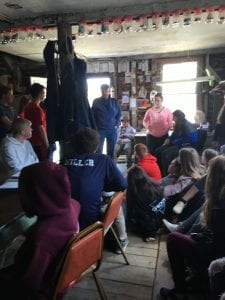 I noticed that there were huge clumps of alewives all packed together trying to swim and they never separated when something happened. When we were in Warren I noticed that the alewives were trying to swim up the fish ladder but the force was too strong and they would get pushed back into where they started. From both Damariscotta and Warren there were tons more fish than I expected and it shocked me how plentiful they were. Seeing the huge clumps at Damariscotta when we first got there amazed me that there were that many fish because I thought there were going to be so much less than there actually were. I wonder if the fish from Damariscotta ever leave that huge clump they were in and just separate to go other places in that river. When we were at the river in Warren and we were talked to about the history of alewives, I found that very interesting because during class we’ve been focusing more on what’s happening with alewives today and restoring things and I found it interesting to get that piece of background information to learn why we are doing what we’ve been doing in class. Like I said in my previous statement about how it was nice to know history and background information about alewives I understand better why we are helping our community by putting sandbags in our marsh or building a new fish ladder. I understand why we have been doing what we’re doing in class thanks to the Warren warden who told us the history of alewives. Throughout the day I was learning a whole bunch of new information I had no idea about and one of those being that I learned how fish ladders work to help the rivers and fish and that they weren’t just there. I also learned about how what we are doing in class relates a lot more to the history of not just alewives in our town but other towns as well. This experience has made me think of why we are helping with stream restoration and that we are headed in the right direction with it. Overall I think our efforts for helping the stream restoration. Laney
I noticed that there were huge clumps of alewives all packed together trying to swim and they never separated when something happened. When we were in Warren I noticed that the alewives were trying to swim up the fish ladder but the force was too strong and they would get pushed back into where they started. From both Damariscotta and Warren there were tons more fish than I expected and it shocked me how plentiful they were. Seeing the huge clumps at Damariscotta when we first got there amazed me that there were that many fish because I thought there were going to be so much less than there actually were. I wonder if the fish from Damariscotta ever leave that huge clump they were in and just separate to go other places in that river. When we were at the river in Warren and we were talked to about the history of alewives, I found that very interesting because during class we’ve been focusing more on what’s happening with alewives today and restoring things and I found it interesting to get that piece of background information to learn why we are doing what we’ve been doing in class. Like I said in my previous statement about how it was nice to know history and background information about alewives I understand better why we are helping our community by putting sandbags in our marsh or building a new fish ladder. I understand why we have been doing what we’re doing in class thanks to the Warren warden who told us the history of alewives. Throughout the day I was learning a whole bunch of new information I had no idea about and one of those being that I learned how fish ladders work to help the rivers and fish and that they weren’t just there. I also learned about how what we are doing in class relates a lot more to the history of not just alewives in our town but other towns as well. This experience has made me think of why we are helping with stream restoration and that we are headed in the right direction with it. Overall I think our efforts for helping the stream restoration. Laney
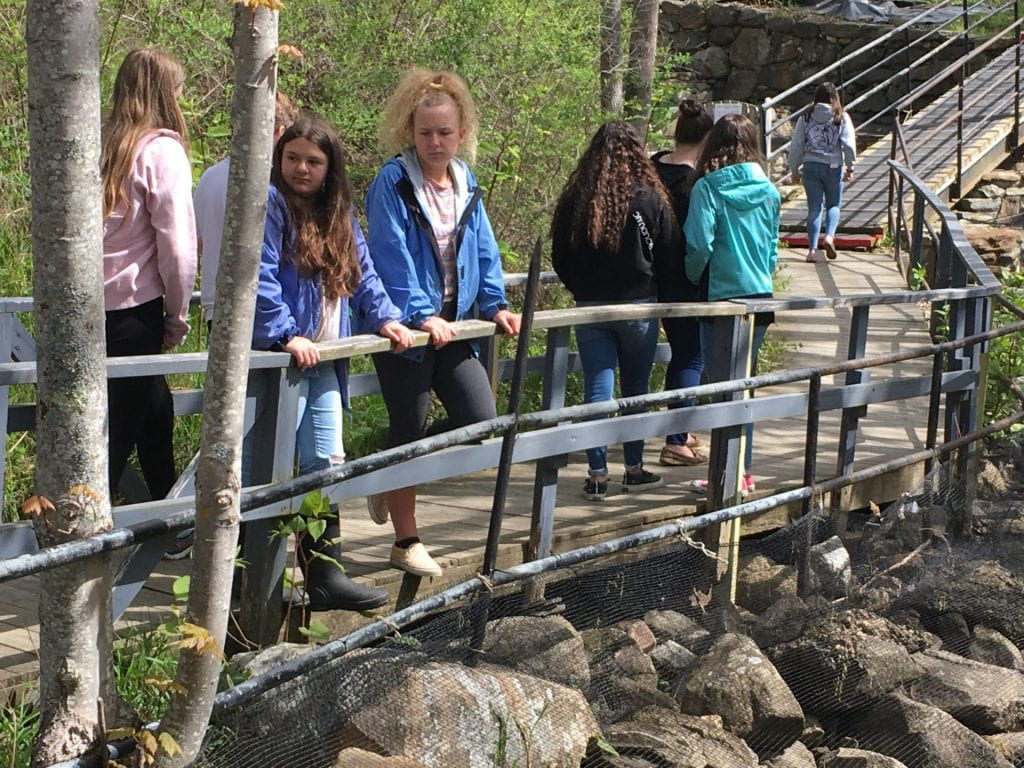 I thought that the experience was very cool and I liked learning new things about our run. I noticed that there weren’t any birds (other than sea gulls) trying to pick at the fish. I expected to see as many fish as I did. What was interesting was that so many people gathered together to make these fish ladders to provide for the fish. I understand better how the fish ladders work. I learned that it took 60 years for the run to come back. Thinking about our run, and our restoration efforts in Tenants Harbor, (I can see) their system is much different in Damariscotta and much more complicated than the one between our culvert and marsh. Lilly
I thought that the experience was very cool and I liked learning new things about our run. I noticed that there weren’t any birds (other than sea gulls) trying to pick at the fish. I expected to see as many fish as I did. What was interesting was that so many people gathered together to make these fish ladders to provide for the fish. I understand better how the fish ladders work. I learned that it took 60 years for the run to come back. Thinking about our run, and our restoration efforts in Tenants Harbor, (I can see) their system is much different in Damariscotta and much more complicated than the one between our culvert and marsh. Lilly
I didn’t think there were going to be that many fish trying to get up into the lake. I thought there was going to be one small school of alewives. I noticed in Damariscotta, all the alewives were in one path following each other, they weren’t swimming all around the whole area, it was a really cool dark path made of fish. There were definitely more fish than I expected. I thought there was going to be just one small school of fish trying to get up into the lake but instead there was a massive amount of fish trying to get into the same lake they were born in, which is really cool. I wondered how they swim against the pressure of the water coming down at them. I also am curious about how long it takes all those fish to get all the way up into the lake in Damariscotta. What I found most interesting was how many fish there were and how the fish made a line (pathway) to get into the lake by themselves. Also, in the smokehouse, it took three days to do the process of smoking them. I would be interested to try a smoked alewife. What I learned that I didn’t know before was that they were cold smoked, and that our run is really small. I think it would have been really cool if we did have a big place like Warren or some place else where alewives would come, and make a cool path in the water and have lots of fish, but I also think it is really cool that we do have a cool small little spot where alewives come and try to get into our marsh in Tenants Harbor. Gwen
 At the Damariscotta alewife run, there was a very successful fish ladder helping thousands of fish climb into the pond. When people said that it looked like you could walk on the fish as if it was a bridge, I thought that they were exaggerating. So as soon as I saw the massive amount of alewives under the bridge and all along the river leading to the fish ladder, I was amazed about how many fish there were. It was definitely more than I expected. I wonder why alewives need to go to the ocean every year if it’s such a struggle to come back to where they were born. I also wonder how so many fish could completely evacuate the river over the course of around two hours. Where did they all go? I think the most interesting thing about the alewives is how strong they are. The water running through the fish ladder seemed very fast and strong, but the alewives could swim through it easily. I understand more about how fish ladders work and how alewives travel after that experience. I learned how many alewives migrated to one spot and I also learned how they were caught. I don’t think our alewife run will be the same as it was before, if it’s even existent, because we have tried many times unsuccessfully and our creek doesn’t have the potential that their river had. Maggie
At the Damariscotta alewife run, there was a very successful fish ladder helping thousands of fish climb into the pond. When people said that it looked like you could walk on the fish as if it was a bridge, I thought that they were exaggerating. So as soon as I saw the massive amount of alewives under the bridge and all along the river leading to the fish ladder, I was amazed about how many fish there were. It was definitely more than I expected. I wonder why alewives need to go to the ocean every year if it’s such a struggle to come back to where they were born. I also wonder how so many fish could completely evacuate the river over the course of around two hours. Where did they all go? I think the most interesting thing about the alewives is how strong they are. The water running through the fish ladder seemed very fast and strong, but the alewives could swim through it easily. I understand more about how fish ladders work and how alewives travel after that experience. I learned how many alewives migrated to one spot and I also learned how they were caught. I don’t think our alewife run will be the same as it was before, if it’s even existent, because we have tried many times unsuccessfully and our creek doesn’t have the potential that their river had. Maggie
Building a Fish Ladder
A Floating Fish Ladder and the Quantabacook Lake Alewives
Timing is everything, especially for alewives! A visit to Quantabacook Lake and the “Quantabacook Dam Open House” on Saturday, May 18th was good timing to learn about an interesting fish ladder design, applicable to our marsh.
George River Trout Unlimited (GRTU) and the landowner of the Quantabacook Dam invited the public to celebrate the return of the alewives to their historic spawning grounds in Quantabacook Lake on Saturday, May 18, 2019. The dam is also the site of Searsmont’s local conservation project between the land owner, GRTU, the Maine Department of Marine Resources, and the U.S. Fish and Wildlife. Presently, when water levels drop, particularly in the late summer or fall, alewives in the lake cannot migrate back downstream. Working together, they hope to collect data to help direct future efforts.
For now, helping the fish get in to the lake in the spring is aided with this fishway technique. It works well on this site when the water is high. Although the run has been very slow this year with all the cool weather and rain, the landowner showed photos from last year with the 30-40′ section of river downstream from the dam teeming with the fins of alewives, pooling and waiting to negotiate their passage over the dam and into the lake. This day, which was not quite warm but not cold either, a few alewives scooted through the “gullies” at either end of the lake. (Click on the link in the caption to see several alewives navigate the gully.)
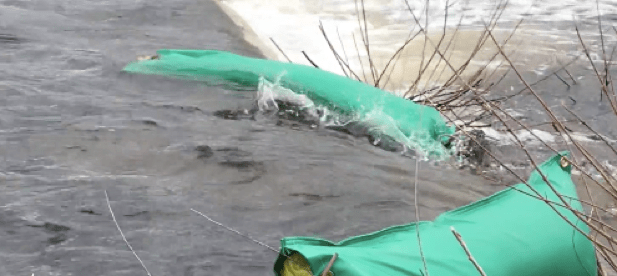
A determined alewife (movie)
During the open house, Marty Bartlett who has been designing the gullies and the fish ladders for low water conditions at Quantabacook Lake explained his floating fish ladder. It’s a narrow trough that channels several inches of water, which will be enough to allow the fish to swim their flow. The front edge attaches to the dam and a metal strap from each front, bottom edge will be pinned into the gravel on the other side of the dam. To get even more water flowing through the channel, a rubber strip extends the height on the edges of the front half. They self-adjust their angle as the water level in the stream fluctuates. Locals also manage the water level in the lake as it exits during the alewife, by putting in “restraining” boards, and put those in place leaving only a 20″ gap in the middle of the dam where the fish ladder attaches. The two “sluices” in the picture below actually are bolted together to handle the numbers of fish that are returning into the lake.
This dam at Quantabacook has a long history as do many of our dams. It was originally built in the late 1790’s so the river between the dam and the village of Searsmont would flood and create a bog that could be used to grow cranberries. In the late 1960’s the dam at the outlet was replaced.
The story of why alewives are even arriving at Quantabacook a tale of another dam: Sennebec Lake dam. While the Sennebec Dam was being built on the St. George River in Union in 1916, observers noted large schools of salmon milling about at the base of the dam. These salmon as well as the shad, alewives and eels were blocked from migrating to their spawning habitats; the ponds and lakes upstream. The dam was originally constructed to produce electricity and was later sold to the Sennebec Pond Association in the 1960’s, who used it only to maintain lake levels.
In 2002, The 12 foot high, 200 foot wide dam and replaced with a rock ramp fishway at the pond’s natural outlet. This opened up another 17 upstream miles of the St. George River as well as 1100 acres of lake habitat in the Sennebec Pond and Quantabacook Lake for migrating fish. It was far too late for the salmon to make a comeback, the alewives are back in Quantabacook, and the Searsmont community is celebrating!
(Sources: http://www.gulfofmaine.org/restoration-gulfofmaine-org/projects/factsheets/SennebecDamFactSheet.pdf, https://freepressonline.com/PrintArticle.aspx?aid=613&uid=b8450d2c-1892-4f57-89d6-c6ae443b8be8, https://www.maine.gov/dacf/municipalplanning/comp_plans/Searsmont_2013.pdf)
Measurement and Moving Boulders
Our first “sneak” to the culvert’s edge to check for fish…Then on to measurements and moving boulders!
We are making small scale models of fish ladders after reading text and evaluating the pros and cons of four basic fishway designs. We want to know the dimensions of the stream and the channel where a fish ladder would be positioned to help work out potential lengths and slopes, given the present water conditions when there is not flooding tide. We got the measurements we were looking for and then some big boulders were cleared from the channel creating fewer obstacles for fish (in potential low water conditions) and also created a more level area for our fish ladder to come.
Thank you Zeke, Jack, James, Henry, Adrien, Lilly and Shaun!
Improving Fish Passage!
Why did we lose our alewife run?
There are several reasons why we lost our run. When people netted the alewives during the 1980’s, they were harvesting adult fish that were trying to reach the marsh in order to spawn. Not really knowing that fish couldn’t reach the marsh to spawn, fish were being taken from the population, while the population wasn’t able to reproduce itself.
This was because fish couldn’t get through a culvert put there during the 1970’s. A metal culvert under Rt 131 was put in during the 1970’s and was put in too high. From this time on, the fish had a hard time to pass through the culvert under the road, and continue into the marsh. However, In August of 2015, that metal culvert was replaced with the cement culvert with weir sections. It was placed lower in elevation, and the weirs create little pools of water inside the culvert to help the fish (and also elvers and any smelt) swim up through the culvert. This allowed fish to pass under Rt. 131 like they used to.
Another positive community action was that each spring, from 2009-2014, the state stocked the marsh with adult alewives harvested from a healthy run elsewhere in the state. These adults spawned in the marsh, and then went back out to sea. The eggs that hatched in the marsh spent the summer there and then went offshore for their first winter, then out to the Gulf of Maine to grow to adulthood. When they became a three or four-year old fish, those surviving fish made their way back to Ripley Creek because they imprinted on our marsh waters where they had hatched!
We should have more returning fish. We should have hundreds returning to the marsh. This will be the fourth spring since the new culvert was put in and fish could reach the marsh, so perhaps this is a year we might see more returning fish. However, we can also wonder if the salt coming into the marsh on spring tides is decreasing the numbers of alewives that hatch from eggs, or survive as fry. We know that these spring tides didn’t happen regularly back in the 1980’s, as they do today.
When Tenants Harbor Alewives Ran -Primary Source Information
Here’s a recap of some of our oral histories about our alewife history at Ripley Creek and the marsh. Our primary source information come from community members we’ve invited into our classroom to share their experiences with alewives. Here are highlights of three visits, one from Randy Elwell this year, and the others from Lyle Morris, and then from Jeff Falla and Robert Morris.
This April (2019), Randy told us about his school days (early 1980’s) and how you’d have to walk down to Mr. Philbrook’s shop class and… “Behind the Grace Institute, down where Phoebe Bly owns now…I can remember going down there in the water with a scale basket. You know what a scale basket is…they have holes in them to let the water out…they would go down there in the crick and they would dip alewives on the tide, the high tide. Everybody in town you’d see down there getting alewives…We used to do it and actually Mr. Philbrook used to let some of the students that were fishermen go out during class and catch alewives. That would have been in the late ’70’s. I went into 6th grade in ’81. …I don’t know if you guys have been to Damariscotta, but the amount of fish that come up, that seemed to be what the crick was like, the fish would come into the crick and go up into the marsh. You just went out into the water, waded out into the water, and dipped and did whatever you could to catch fish. And I’ve heard of guys back in the day, some of the older guys in town, used to run seine twine across the cove and wait for the tide to get high and run it across when the tide went, the fish would go against the (twine) and they’d go bail them out, which is highly illegal now.”
“The mentality was that the alewives weren’t going to go away; just like anything in the fishing industry or anything it’s going to be there forever, and the crick, especially. But it did, it went away and got less and less and less.”
“My family’s been in the fishing business for generations so I grew up around it…When I was a kid…going with my father in the bait truck, the big bait truck, to the alewives trap in Warren, filling the truck and going and delivering it and then coming back and getting more…Now…you have to go and get in line or sign up to get a tray of alewives, whereas then, it was, you just went and get as much as you wanted and then took it home.”
We asked Randy if he ever ate alewives. He said, “Oh yeah (making a face). My father-in-law smoked ’em for years. He had a smoke house. He’d go over to Warren and he had a friend… ’cause as a resident of Warren you could get so many…have so many free; he would get his alewives and he would smoke ’em and people would come from, I ain’t kidding ya’, all the way from like Presque I’sle, just to get ’em. He did it for years and years…Dried fish, salt fish, peel it off and eat it. Do the same thing with the smoked alewives. The older people really liked them. They would heat them up or some people would peel them off and eat them.”
Lyle Morris told us about netting alewives for bait from what turned out to be the last native run (around 1985 or 1986). Notes from his 2016 class visit capture the following information: Lyle Morris stated that the alewife run was never large. They were caught in Ripley Creek, netted as they collected in the pools below the culvert. They were caught by perhaps 3-5 different local people for lobster and halibut bait. It would be frozen if the halibut season was over and kept for the next halibut season (a year later). As a kid he remembers three rock pools that would be fixed up year to year, so they pooled the water and fish could collect and rest in the pools before going up into the marsh with the tide. About 1985, Lyle netted about 6-8 bushels in the creek, and after that, “like a switch”, they stopped coming. He thinks he’s seen maybe two alewives there since the 1980’s.
We also have a story from two life-long friends that used to play in Ripley Creek. In March of 2016, Mr. Jeff Falla and Mr. Robert Morris came into the eighth grade class to talk to us about their memories of alewives.
When Robert and Jeff were younger, they would catch the alewives for fun with a colander and then they would flip them over the beaver dam into the marsh to help them get there. They mentioned that there was never a big run, but a couple lobstermen from Wheeler Bay did come to catch some alewives for lobster bait when the fish ran in the spring.
Robert and Jeff remembered how the sewage from houses had run from the backyards of those houses and down into the marsh. After swimming in the creek they would come out with red blotches all over their body. When the house that used to be on the granite piling over the stream flushed the toilet, it would go right into the creek. Back then, there were bottom feeding fish, like flounder, that would come all the way up the creek as far as the culvert. They explained that they believed the fish would feed off the solid waste. They used to see mackerel in the creek too. When the water quality improved, the flounder and mackerel seemed to disappear. The water is a lot cleaner today. Now, the only thing that runs into the marsh from houses is gray water. When we were working in the stream we saw water coming out of a pipe several times.
“Scouts”! (When Alewives Return)
“The term “Scouts” comes from our forefather’s observations on the nature of the alewife spawning migration. A school of prime alewives, males I’m told, are the first to ascend the river and somehow they communicate back to those in the estuary that the river is passable. How these fish communicate back is not known. Some say individual fish return with the information, others suggest a scent is given off that communicates the condition.
The first Alewives, the Scouts, went up the river April 16th, (2018) according to my fish watchers. That was when the ospreys and cormorants were observed fishing early in the morning, for a number of days. The schools of alewives were in the lower river where there were flocks of cormorants observed by me and others in the area of Spears Mill Brook, behind the Prison farm.”
Personal communication to Alison England from Ed Courtenay, May 6th, 2018
(Mr. Courtenay is the town of Warren’s “Alewife Warden”)
Fast forward to the morning of April 24th, 2019, with 3.61″ of rain to date in April and waters running high, and the following scene upstream of the bridge on the St. George River at the Thomaston and Warren town line. It sure looks like the “scouts” have arrived!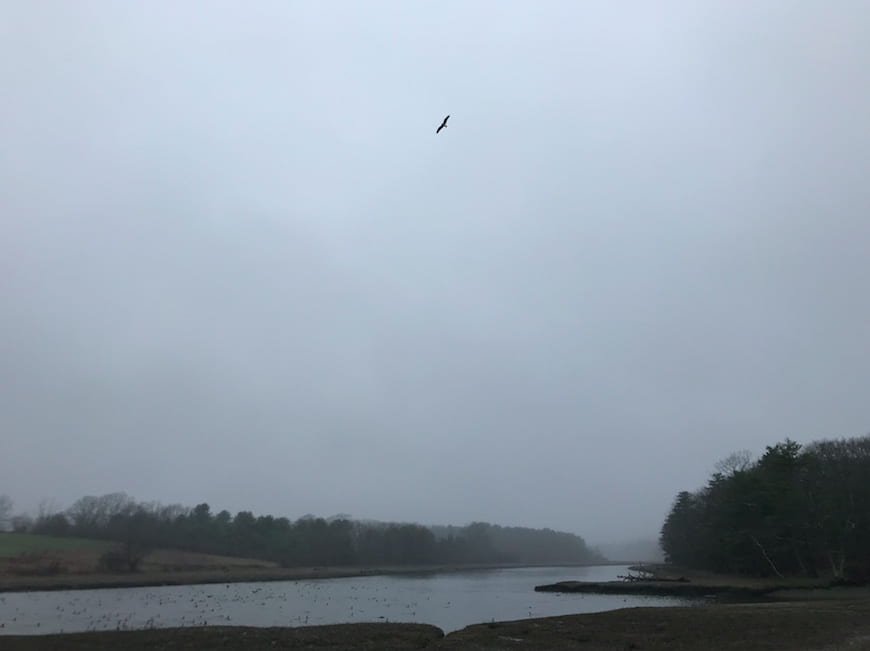


Alewives Are In Our Pools!
Confirmation!! We have returning alewives this spring! Thanks to the curiosity of Madison and Breannah while on an evening bike ride past the culvert, they walked in to discover two alewives. The next morning they reported to Mrs. England, “We are pretty sure they are alewives” and “They are big!” who promptly hugged both of them!
This was on Tuesday, June 12th, our school-wide Celebration of Learning open house for our entire St. George Community. How fitting! At lunchtime, any and all were invited to see if the fish were still there in the culvert. It turned out, they were in our pools, swimming and continuing up the stream until they reached the foot of our slide. Conservation Commission member Jonathan Coggershall was contacted and as he too looked on, he prompted the idea of netting them since we were mid-tide cycle, and a big tide wasn’t coming in until evening.
Students, some lucky 8th grade students donning hip boots and nets, watched and waited with the rest as we all enjoyed the side by side passes of the fish. It was truly magic to see them swimming in our stream. We watched as they made many passes near the small inlet to the final channel where the marsh waters spill into the stream. Finally, one fish made the entry and then we were able to net it in the narrow constriction of waters. Mila had the honor of putting that fish into the marsh.
After school was over for the day, four students were able to stay after and patiently wait for another opportunity to net. Again, Mila was charmed and had the second fish in her net before she even realized it was there. The sun was no longer playing on the water so directly, but keen eyes and tell-tale ripples all but erased the water between us and the fish. Our job for this day was absolutely complete!










